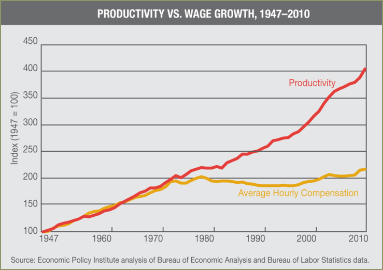Labor
For many people in the workforce, pay and benefits will be determined by the forces of supply and demand. Just as supply and demand determine the price of products, supply and demand determine the wages that workers receive as well as the wages that suppliers must pay.
The first point to keep in mind is that the demand for labor is derived from the demand for the products that people buy. If you want to be paid well, make sure you have the skills to make the products people desire the most. For example, in this era you want to be a software engineer instead of the best typewriter repairman in town.
While the demand for labor is derived from the demand for a product, other influences factor into pay as well. First of all, wages in this country have traditionally risen with productivity. However, as the chart on the right shows, beginning in the mid-1970s, rising productivity failed to result in commensurately rising wages for workers.

One example of this trend is farming. Farmers of today still work the same long hours as farmers of the past, but since today's farmers are more productive (with better equipment, fertilizers, etc.), their income is greater.
Why is there such a vast difference in what people earn? Human capital is the key to higher pay. People with professional degrees, like doctors, lawyers, and accountants, make a huge investment in education. Professional occupations require years of study and a degree serves as proof that the recipent is qualified to practice that profession. This requriement serves as a barrier-to-entry which limits the supply of eligible workers and raises salaries of qualified workers. There is a direct correlation between level of education and earnings. Also, in today's economy, there exists an inverse relationship between level of education and unemployment. A college degree, or other post-secondary education, seems to be the key to prosperity. See Employment Projections to learn more about the relationship between level of education and earnings.
One of the key factors of human capital is the difference between skilled and unskilled workers. Electricians, plumbers, mechanics, and other similar workers usually complete some sort of internship or specialized training of specific skills before they are given licenses to perform work for customers.
These skilled jobs, with their limited supply, will earn more than a job that requires very little skill or training. Many minimum wage fast food jobs, or service related jobs, require a minimal amount of training before workers can complete all tasks associated with the job. A simple rule to remember is that the greater the supply of potential workers for a job, the less that job will pay.
Another factor to consider in what people are paid is working conditions. Some jobs are very unpleasant, dangerous, or noisy. These compensating wage differentials are evident in jobs in steel mills, oil platforms in the ocean, crab fisherman in Alaska, or construction workers. The rule of thumb is that to attract people to jobs that will make them tired or dirty, risk injury, or be miserable in general, an employer will have to pay more. If you want to be clean, pleasant, and engage in friendly conversations with customers, you should expect to be paid less.
No discussion of wages is complete without a discussion of persistence of discrimination in the workplace. While many gains have been made with race relations over the last five or six decades, there is still evidence of at least some discrimination in the workplace. Read Racial and ethnic characteristics of the U.S. labor force, 2011 to learn more about how the labor force can be broken down by racial and ethnic characteristics, and how each group is performing in the current economy.
Racial and ethnic characteristics of the U.S labor force, 2011
Now with a basic understanding of the labor market, read the following article to get a breakdown of the current employment trends among men, women, youth, races, and educational attainment. Read An Overview of Economic, Social, and Demographic Trends Affecting the U.S. Labor Market to learn more about the labor market. You will use this article to complete a task later in the lesson.